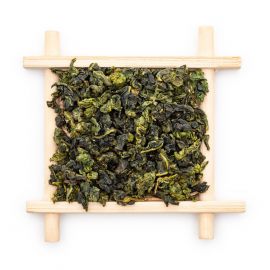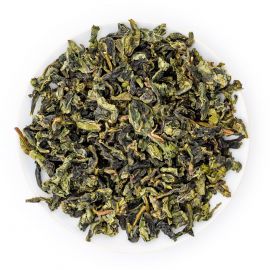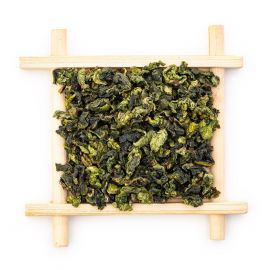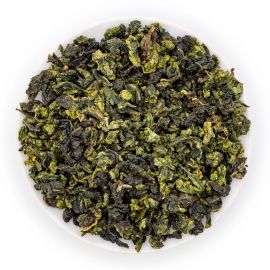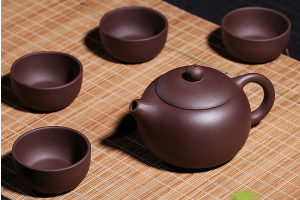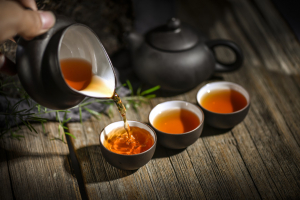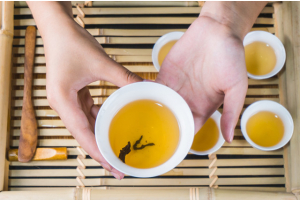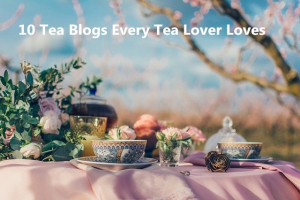
Tie Guan Yin Tea, the Representative of Oolong Tea. The name of tie guan yin is also known as ti kuan yin, iron buddha, or iron goddess of mercy. It is a type of oolong tea from Anxi in the Fujian Province, China. Tie guan yin is not only the name of tea but also the name of tea tree varieties. Tie guan yin oolong tea uses green tea’s finishing technique as well as black tea’s fermenting skill, so it is a semi-fermented tea between green tea and black tea.
History
The history of tie guan yin tea can be dated back to the year 1725 in Qing Dynasty. So it is often called tie guan yin 1725. In 1741, Emperor Qianlong got this tea and he liked it very much. He looked at the tea leaves that are dark and firm, heavy like iron, taste flavorful, and look beautiful, like "Guanyin", so the tea was named "tie guan yin". Due to excellent quality, unique fragrance, tie guan yin has spread throughout southern Fujian, northern Fujian, Guangdong, Taiwan, and other oolong tea areas.
Tea Garden
Tieguanyin comes from Anxi county which is mountainous. Anxi is a subtropical monsoon climate with a mild climate, abundant sunshine, rainfall, light, heat, and water resources. It has four distinct seasons, the large temperature difference between day and night, obvious seasonal changes, and relatively low temperature, high humidity, and foggy climate characteristics, which provide superior conditions for the growth of Tieguanyin and the formation of excellent quality. What is even rarer is that Anxi is close to the sea, but it has a barrier between mountains and is not affected by the sea breeze. Throughout the microclimate zone, the tea area is hazy all year-round, with fresh air and no pollution. This unique ecological environment is more conducive to the growth of Tieguanyin and the formation of excellent quality.
Varieties of Tie Guan Yin Tea
If you consider this Chinese oolong tea by roasting level you may find three subtypes:
Qing Xiang (clean aroma or lightly roasted), this variety of tie guan yin with a light green jade color. The aroma and taste are flowery making it closer to a green tea.
Nong Xiang (strong aroma or heavily roasted), This variety of tie guan yin is warm, complex, yet less flowery in essence. This variety uses traditional baking techniques to achieve the final product.
Yun Xiang (yun aroma or moderately roasted), this variety of tie guan yin combines the floral aroma and the exquisite taste from the previous ones.
What is the process of making Tieguanyin tea?
Tea-making process.
Tieguanyin tea's harvesting technology is special, not picking very young shoots, but picking 2-3 leaves of mature new shoots, commonly known as "Banjhi-plucking ", which means that the leaves have all been unfolded and formed when they are planted.
The processing includes sun withering, tossing,rolling, picking.
- Sun withering. There are three different methods to doing this: direct sunlight, natural wind, and heating inside a house. Firstly, it is advisable to the sun at 4 o'clock in the afternoon when the sun is soft. This step helps the leaves lose water and soften under the heat of the sun. When the leaves have been sufficiently sun withered, the third step is cooling. Leaving the leaves in a cool place in the house will help the leaves lose water evenly throughout them. They should be distributed averagely and not placed together so they can cool separately.
- Tossing is also known as “zuoqing” in China. This is a unique step for Iron Goddess and other oolong teas. Only Oolong tea will be made using this step. They are placed inside a barrel and tossed. This is the step for Tieguan yin’s “green leaves within red edges” and flower fragrances.
- The rolling and baking of Tieguanyin are repeated many times. When the product aroma is condensed, the taste is mellow, the appearance is bright, and the surface of the tea stick is agglomerated with a layer of hoarfrost, the next step can be done.
- The tea leaves are finally picked up when the stem pieces and impurities are removed.
Tie Guan Yin Tea Benefits
Tie guan yin tea is rich in nutrient substances. Tie guan yin tea is high in amino acids, polyphenols, and antioxidants. The tea also contains vitamins, particularly vitamin C, and other components such as calcium, fluorine, iron, magnesium, manganese, phosphorus, potassium, and zinc.
Dinking tie guan yin tea helps improve your sluggish digestion. Stomach aches and acid reflux may be soothed by a good cup of tie guan yin tea after your meal.
Weight loss is the combined effort of a healthy diet and exercise. And the caffeine in tie guan yin tea helps your feel energized and build momentum as you exercise.
Polyphenols and antioxidants in tie guan yin tea would play an important role in helping to improve your heart health.
Tie Guan Yin Tea Brewing
To brew tie guan yin tea, Yixing clay teapot or porcelain Gaiwan suggests for brewing tool.
Brewing in Chinese Gongfu Way:
Serving size: 3 grams.
Water: 150ml with a temperature of 95℃–100℃.
5 steeps: rinse, 15s, 25s, 35s, 45s, 55s.

